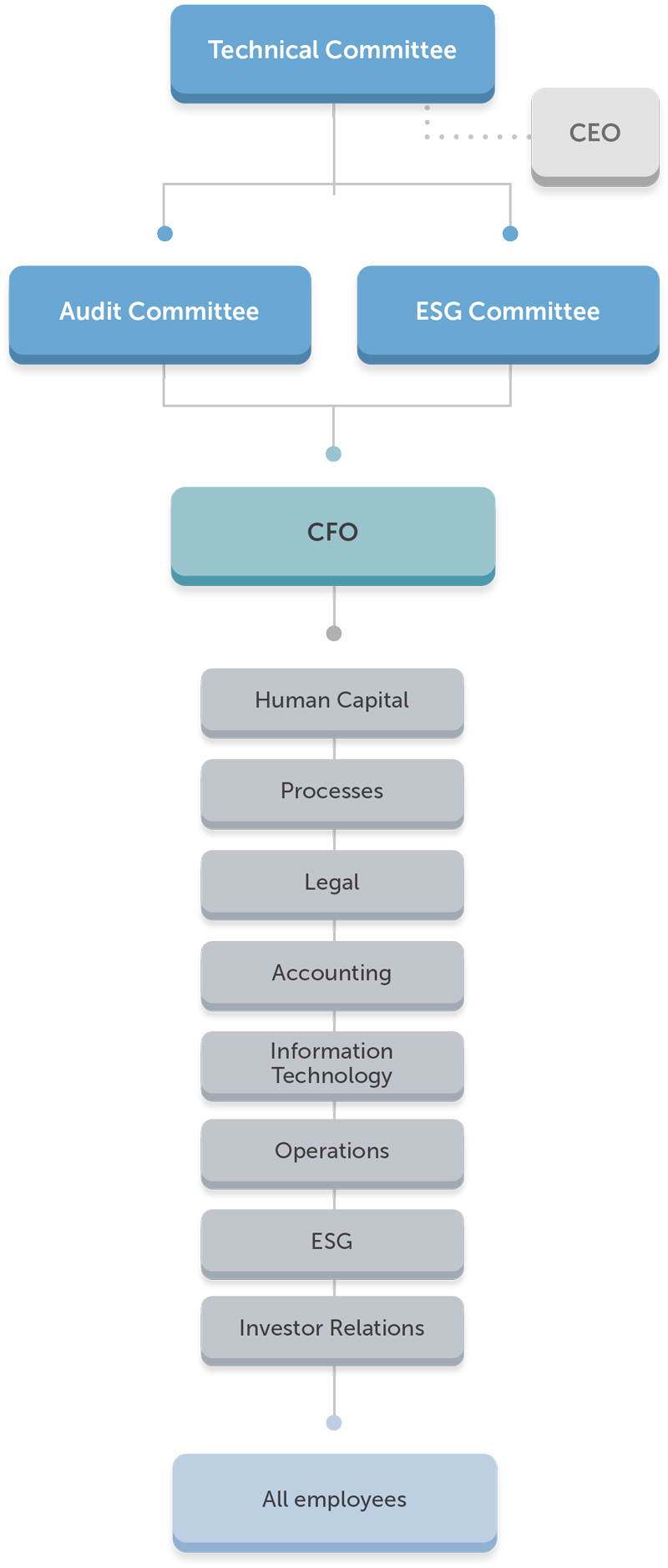2-12, 2-23
Risk management
The risk management approach taken by Fibra Danhos enables the organization to take advantage of opportunities while managing the risks associated with these activities.
In 2023, the Risk Management Policy, was created and accepted by the Technical Committee as part of the enterprise-wide Risk Management Framework. The policy sets out the principles, goals and approach for ensuring optimal and comprehensive risk management.
The management of risks related to health and safety in Fibra Danhos’ work area are included in the Occupational Health and Safety Policy.
Additionally, within our institutional risk assessment process, the dual materiality analysis is updated every two years.
Governance
Proper management of the risks to which the company is exposed is the result of a good governance structure that integrates and aligns all areas under a common focus. With this we can decide not only what risks we face, but also the means to mitigate them. At Fibra Danhos, we have clearly defined roles and responsibilities for every position and area responsible for managing these risks.
Technical Committee
The Technical Committee, through the experience and knowledge of its members, is responsible for the early identification of potential risks, as well as the implementation of preventive and corrective measures to protect the interests of the FIBRA and its stakeholders.
Audit Committee
Monitors possible non-compliance and requests the opinion of the advisor and/or independent experts when it deems appropriate.
ESG Committee
The ESG Committee is responsible for overseeing and monitoring the management of climate, social and governance risks, and reporting to the Technical Committee on these.
Executive level
Responsible for risk management, which encompasses identification, monitoring, mitigation plans, and reporting, the CFO relies on various business areas under his direct supervision. These include Human Capital, Processes, Investor Relations, and Information Technologies, as well as those overseen by the CAO, Operations, and ESG, along with the Legal department. Together, they determine FD’s risk appetite and tolerance.
Employees
All employees are responsible for ensuring that they meet legal, regulatory and corporate policy requirements. This includes promptly reporting any identified risks through the appropriate reporting channels. Fibra Danhos expects all employees to act as risk managers, in line with internal policies, including the Risk Management Policy.

Fibra Danhos recognizes the need for effective risk management as a fundamental ability, and also expects all employees to act as risk managers.

Analysis of material risks
We map risks according to a double materiality analysis that identifies and evaluates present and future exposures to determine their possible negative impacts and thus enables us to decide on measures to eliminate or minimize these material risks.

Parque Lindavista

IF-RE-130a.5, IF-RE-140a.4
| RISK | EXPLANATION | POSSIBLE IMPACT | CONTROL MEASURES | CLASSIFICATION |
|---|---|---|---|---|
| Cybersecurity | Possibility of cyberattacks by which others gain access to confidential or sensitive information handled by Fibra Danhos, affecting privacy and commercial rights | Unauthorized access to confidential or sensitive business information could violate privacy rights, causing stakeholder distrust, lawsuits against the company or sanctions from the authorities. |
|
Real |
| Community engagement | Possibility of the community developing an antagonistic attitude towards the company’s operations, causing an atmosphere of distrust and limiting local support or even a possible shutdown of operations. | Possible deterioration of the relationship with communities, with loss of social license could lead to complaints intending to cause a shutdown of operations. |
|
Real |
| Natural disasters and climate change | Because our properties are located in an active seismic zone, they are exposed to telluric movements of significant magnitude, compromising the physical integrity of the properties and their users. In addition, the properties are located in areas of critical water stress, which increases their vulnerability to heat waves, poor air quality and flooding. This could be intensified by climate change, compromising property operations and the well-being of their occupants. | These factors could lead to operational stoppages, fines and penalties, increased operating costs and structural damage to buildings. |
|
Real and emerging |
| Emissions | Because the organization’s operations generate GHG emissions, if Mexico makes more ambitious commitments to the Paris Agreement or investors become more demanding, a mitigation plan must be in place to avoid an abrupt increase in operating costs. | Failure to take the pertinent measures could generate legal sanctions and increased operating costs. |
|
Emerging |
| Energy | Since the energy consumption of our operations comes mainly from non-renewable sources, such as fossil fuels, relying on these non-renewable natural resources could compromise the operational continuity of the business in the long term. | Addressing energy transition requirements could increase operational costs. |
|
Real |
| Water | Our dependence on water resources could compromise operating continuity by operating in areas of critical water stress. In addition, consuming water in critical stress zones could foster negative perceptions among stakeholders, with possible shutdown of operations. |
Stakeholder dissatisfaction with the lack of water could lead to the shutdown of operations and could generate a loss of reputation. |
|
Real |
| Talent recruitment and retention | Possibility that labor trends related to the demand for living wages and benefits higher than required by law could increase employee turnover. | Increased employee turnover would mean lower productivity. |
|
Real |
| ESG leadership | Failure of Fibra Danhos’ highest governance body to adopt a responsible business philosophy and a long-term operational continuity approach that incorporates ESG criteria and risks, or decisions made without understanding their impacts, could lead to the loss of investment opportunities | The consequences may vary in type and scope, but investors are the main stakeholders in maintaining a sustainable and responsible investment approach. If we do not have a solid approach to sustainability, we could lose the confidence of investors, reducing investment opportunities. |
|
Emerging |
| Technology and innovation | Failure to invest in acquiring or updating technology could affect productivity, efficiency, competitiveness and the ability to adapt to changes in the sector, reducing service quality. | Failure to invest in technology could limit our ability to innovate and remain relevant in the market, reducing attraction of new customers and tenants and increasing complaints. |
|
Real |
| Tenant relations | Failure to properly channel tenant complaints and grievances could cause friction in the relationship, generating distrust and even loss of tenants | Lack of effective communication and respectful treatment can generate mutual distrust, increasing the likelihood that tenants will not report problems in a timely manner, reducing retention in the long term. |
|
Real |
| Human rights | If Danhos directly or indirectly violates any human right and this is not detected in time by the company to manage the impact, it could lead to lawsuits by the affected parties, causing stoppage of operations and loss of investment opportunities. | The lack of a human rights due diligence procedure and/or failure to follow it correctly could lead to lawsuits that could result in operational stoppages, loss of credibility, loss of reputation and, therefore, loss of investment opportunities. |
|
Potential |
| Ethics and anticorruption | Involvement by any representative of the organization in illicit and/or corrupt acts would affect our reputation. | Corrupt practices violate the law of the states where we operate and also, go against the organization’s Code of Ethics and values; this could cause a loss of stakeholder confidence and sanctions or lawsuits. |
|
Potential |